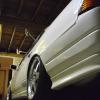Announcements
-
Similar Content
-
Latest Posts
-
Trail braking done right, should have the rear unsettled, such that you're actually turning the car by a noticeable amount WITH the brakes, and hence noticeably less steering input.
-
No you don't. Just no more driving in the wet, and clean your window manually before you drive
-
I'm not sure if they tick your boxes, but Haltech would be my pick. I'm an Adaptronic guy from way back, and Haltech acquired Adaptronic to basically get Andy, AND his IP on how he does things like fuel modelling etc.
-
Just on this, as there's a huge issue in your assumption Dose. The logic you've given, is the same logic old school NA guys give for "needing back pressure" in an exhaust. If you free up an exhaust system, and keep injecting the same fuel in etc, at the same timing, you'll typically drop power. Freeing the exhaust will often make an engine want a little bit more timing, and even sometimes a little more fuel, but then it'll make even more power. There's many mods people do and "get no extra power" when running a comparison on the same tune. Imagine a car tuned for 91, but now we say put 98 in it, see no difference. But as we now have 98 fuel, you can run more timing, and make more power, as the 91 was knock limited. So just be very wary in your claim of "don't retune it and do a back to back and you'll see". The correct approach would be tune the car with stock manifold, swap the manifold to aftermarket, and retune it again. But no one wants to do that, and all the results we get are "this was stock, and this is manifold changed and tuned" and people put it all down as just the tune doing it.
-
Unplug ECU. Unplug TPS. Unplug boost pressure sensor. Now, all the wires, placing your ground (black) multimeter lead at the ECU end, measure resistance of the 5V line at the boost sensor plug. Then do the same to the TPS plug. Then do the same for all the other wires that relate to the TPS, or boost sensor. All of your measurements should be very very low. You're looking to see if wiring is out of wack here. Secondly, from memory on the R33 (not a neo motor, so I'm assuming an r34) the ground wire for the TPS and boost sensor are NOT equal to ground of the car/battery. IE, DO NOT connect ground of the sensor to the engine/body of car. You'll get a ground loop, and/or potentially screw shit up. In electronics, ground for a circuit, is not necessarily equal to ground of another circuit. So this leads me to ask, when measuring your 5V, how are you getting 1.5V? Where are your multimeter leads touching for both the red and black lead on the multimeter? If you're measuring power on the sensor wire, and putting ground on the car chassis or negative battery terminal, that could be all of your issues in "getting 1.5v". Electronics engineers can do some funky stuff with circuits, and when both sensors are on, it's enough laid to alter how the ECU is functioning.
-




Recommended Posts
Create an account or sign in to comment
You need to be a member in order to leave a comment
Create an account
Sign up for a new account in our community. It's easy!
Register a new accountSign in
Already have an account? Sign in here.
Sign In Now